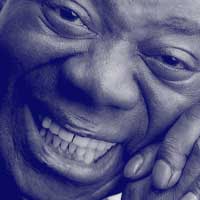Louis Armstrong Biography - A Very Quick Guide
Louis Daniel Armstrong (usually pronounced 'Louee' in the French pronunciation with a silent s) (August 4, 19011 – July 6, 1971) (also known by the nicknames Satchmo and Pops) was an American jazz musician. Armstrong was a charismatic, innovative performer whose musical skills and bright personality transformed jazz from a rough regional dance music into a popular art form. Probably the most famous jazz musician of the 20th century, he first achieved fame as a trumpeter, but towards the end of his career he was best known as a vocalist and was one of the most influential jazz singers.
Contents |
Early life
Armstrong was born to a poor family in New Orleans, Louisiana. The date of his birth is August 4, 1901. His youth was spent in poverty in a rough neighborhood of uptown New Orleans, as his father, William Armstrong, abandoned the family when Louis was an infant. He first learned to play the cornet (his first of which was bought with money loaned to him by the Karnofskys, a Russia-Jewish immigrant family) in the band of the New Orleans Home for Colored Waifs, where he had been sent multiple times for general delinquency, most notably for a long term after (as police records show) firing a pistol into the air at a New Year's Eve celebration. He followed the city's frequent brass band parades and listened to older musicians every chance he got, learning from Bunk Johnson, Buddy Petit, and above all Joe 'King' Oliver, who acted as a mentor and almost a father figure to the young Armstrong. Armstrong later played in the brass bands and riverboats of New Orleans, and first started traveling with the well regarded band of Fate Marable which toured on a steamboat up and down the Mississippi River; he described his time with Marable as 'going to the University' since it gave him a much wider experience working with written arrangements. When Joe Oliver left town in 1919, Armstrong took Oliver's place in Kid Ory's band, regarded as the top hot jazz band in the city.
Early career
In 1922, Armstrong joined the exodus to Chicago, where he had been invited by Joe 'King' Oliver to join his Creole Jazz Band. Oliver's band was the best and most influential hot jazz band in Chicago in the early 1920s, at a time when Chicago was the center of jazz. Armstrong made his first recordings, including taking some solos and breaks, while playing second cornet in Oliver's band in 1923.
Armstrong was happy working with Oliver, but his wife, pianist Lil Hardin Armstrong, urged him to seek more prominent billing. He and Oliver parted amicably in 1924 and Armstrong moved to New York City to play with the Fletcher Henderson Orchestra, the top African American band of the day. Armstrong switched to the trumpet to blend in better with the other musicians in his section. During this time, he also made many recordings on the side arranged by an old friend from New Orleans, pianist Clarence Williams; these included small jazz band sides (some of the best pairing Armstrong with one of Armstrong's few rivals in fiery technique and ideas, Sidney Bechet) and a series of accompaniments for Blues singers.
He returned to Chicago in 1925 and began recording under his own name with his famous Hot Five and Hot Seven with such hits as 'Potato Head Blues', 'Muggles' (a reference to marijuana, for which Armstrong had a lifelong fondness), and 'West End Blues', the music of which set the standard and the agenda for jazz for many years to come. Armstrong's trumpet introduction to 'West End Blues' remains one of the most famous and celebrated improvisations in jazz history.
Armstrong returned to New York in 1929, then moved to Los Angeles in 1930, then toured Europe. After spending many years on the road, he settled permanently in Queens, New York in 1943. Although subject to the vicissitudes of Tin Pan Alley and the gangster-ridden music business, he continued to develop his playing.
During the subsequent thirty years, Armstrong played more than three hundred gigs a year. Bookings for big bands tapered off during the 1940's due to changes in public tastes: ballrooms closed, and there was competition from television and from other types of music becoming more popular than big band music. It became impossible to support and finance a 16-piece touring band.
The All Stars
Around 1950, Armstrong cut his band down to six pieces, going back to the Dixieland style that made him famous in the first place. This group was called the All Stars, and included at various times Barney Bigard, Jack Teagarden, Trummy Young, Arvell Shaw, Marty Napoleon, Big Sid Catlett, and Barrett Deems. During this period, he made many recordings and appeared in over thirty films. In 1964, Armstrong recorded his biggest-selling record, Hello, Dolly.
Armstrong kept up his busy tour schedule until a few years before his death. While in his later years, he would sometimes play some of his numerous gigs by rote, but other times would enliven the most mundane gig with his vigorous playing, often to the astonishment of his band. He also toured Africa, Europe, and Asia under sponsorship of the US State Department with great success and become known as 'Ambassador Satch'. While failing health restricted his schedule in his last years, within those limitations he continued playing until the day he died.
Armstrong died of a heart attack in 1971 at age 69, the night after playing a famous show at the Waldorf Astoria's Empire Room. He was interred in the Flushing Cemetery, Flushing, New York.
Top Pieces on 8notes by Louis Armstrong
